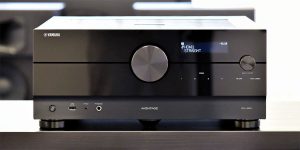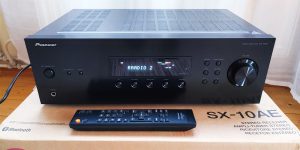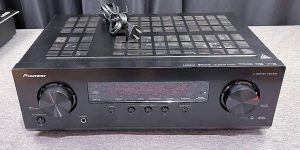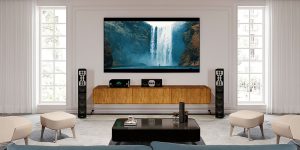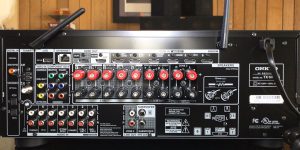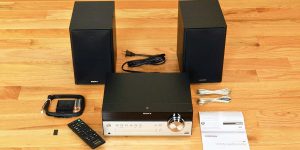It is hard to overestimate the impact of Dolby Atmos technology on the modern world of surround sound and, consequently, viewers/listeners. Each of us, having learned about the existence of a unique sound picture that can be recreated at home with the help of special equipment, has probably thought about buying one. After all, the definition of “home theater” makes us want to get at home the effect and impressions we get in a real movie theater. For this reason, for my review, I have selected the best Dolby Atmos receivers, the most popular in 2025 and capable of recreating a full, “real” support of the surround sound format that makes you feel like you’re in the center of the action. It should be informative and useful!
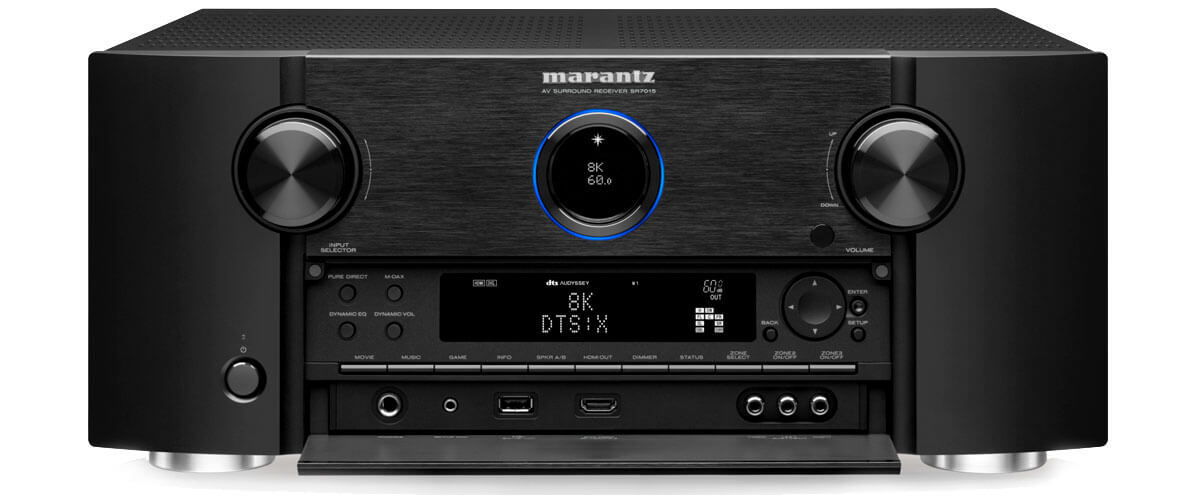
Atmos receivers comparison table
| Name | Channels | Power output | HDMI in/out | Bluetooth/Wi-Fi | Review |
|---|---|---|---|---|---|
| Marantz SR7015 best overall | 9.2 | 125W/8 Ohm, 165W/6 Ohm | 8/3 | yes/yes | Review |
| Denon AVR-X2800H budget | 7.2 | 100W/8 Ohm, 210W/6 Ohm | 6/2 | yes/yes | Review |
| Onkyo TX-RZ50 also great | 9.2 | 120W/8 Ohm, 250W/6 Ohm | 7/2 | yes/yes | Review |
| Denon AVR-X6700H premium | 11.2 | 140W/8 Ohm, 175W/6 Ohm | 7/3 | yes/yes | Review |
What is Dolby Atmos?
Dolby Atmos emerged in 2012 and gained acceptance within an extremely short time. The technology involves extending the basic surround sound configuration using 5 or 7 speakers placed around the viewer by adding overhead channels. In this way, sound streams at you from all sides, literally immersing you in the center of the events you see on the screen.
This surround sound format uses up to 118 soundtracks, so the sound is not limited in space, and every detail is where it belongs concerning the viewer. At the same time, 10 additional soundtracks are reserved for dialog and do not mix with other sound objects.
What you need to support Dolby Atmos fully
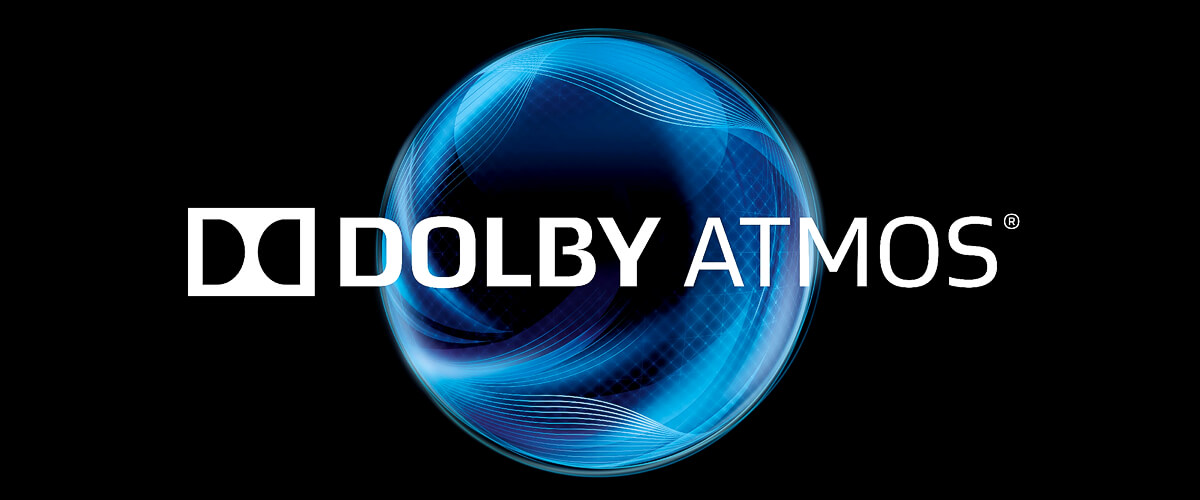
AV receiver
First of all, the AVR itself must support Dolby Atmos. But support for the surround sound format does not mean that you will get the proper effect because you need to have sufficient channels. The thing is that some manufacturers speculate on the popularity of the technology and equip budget devices with an insufficient number of channels with it or its virtual versions. Thus, the receiver can decode the soundtrack, but you will not hear what the sound engineer meant.
To get the “real” full Dolby Atmos effect, to really immerse yourself in the “sound sphere”, you need 7 or 9 channels (and more, but not less), of which 2 or 4 are allocated for highs. This way, you can build 5.1.2 or 5.1.4 configurations, where 5 means the number of floorstanding speakers (a center speaker and two each of front and side speakers), 1 is a subwoofer (there can be more), and 2 or 4 is the number of ceiling speakers.
My review will only talk about AV receivers with full Dolby Atmos support, from minimal to ideal configuration:
- 7.1 or 7.2 receiver (5.1.2 configuration) – minimal system.
- 9.1 or 9.2 receiver (7.1.2/5.1.4) – optimal but budget system.
- 11.2 or 13.2 (7.2.4/9.2.2 or 7.2.6/9.2.4) – ideal system.
Home theater speakers
To achieve the full effect, you will need what are known as high-firing speakers (in-ceiling or on-ceiling) with wide dispersion.
Also, as an alternative, users often use upward-firing speakers, but they simulate overhead channels and, therefore, cannot be considered ideal for this technology.
Dolby-enabled content
It cannot be said that today, the content with Dolby Atmos soundtrack has flooded the entire multimedia space. Therefore, I dare to say that if you buy an Atmos-ready receiver today, you are making the right choice in favor of the future.
If you like to watch movies from disks, you will easily find movies with this soundtrack. Especially those released in recent years. But also streaming services are offering more and more content with Dolby Atmos surround sound format. Some of the most popular ones include Netflix, Disney Plus, Amazon Prime Video, Apple TV, and Rakuten.
You can also find sports broadcasts (BT’s Total Entertainment package) and computer games with Dolby Atmos.
Best Atmos receivers review
Marantz SR7015 – best overall

Marantz SR7015 carries the torch of the winner of my rating to the sound of drums. Being originally a 9.2 AVR, it can serve as an 11-channel system if desired. The premium 2020 model is no longer in the official Marantz lineup, so it’s a good time to pick up the SR7015.
The receiver offers 125V of power (8 ohms, 20Hz – 20kHz, 2ch). It may not be the highest in the rating, but the THD distortion figure of 0.05% tells us that the sound is clear and crisp even at high volume. In addition, the receiver’s design utilizes an HDAM hyperdynamic amplifier module that outperforms conventional DUT ICs.
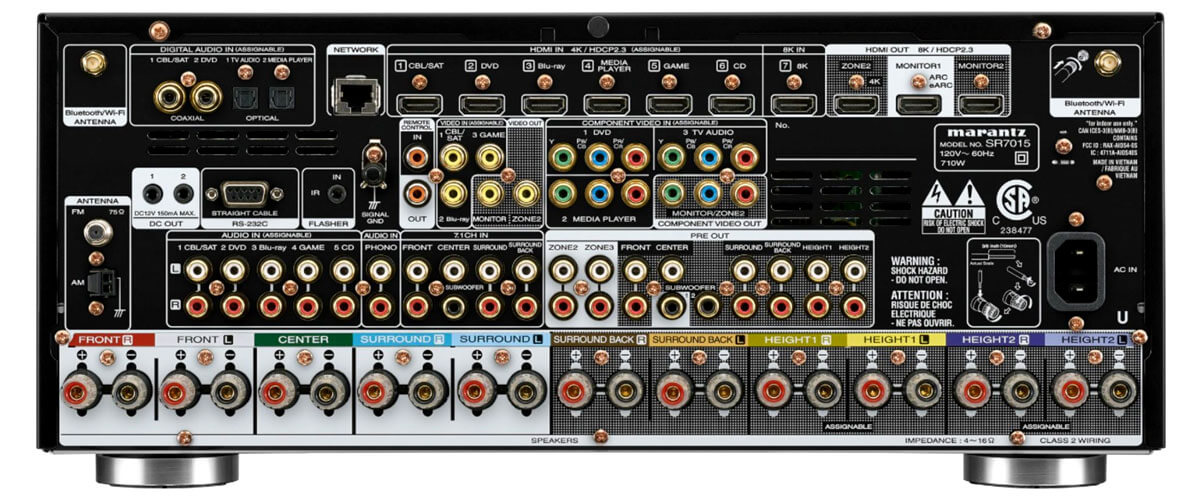
The Marantz SR7015 has a huge number of different types of connections. You can assemble most of your new or old equipment into a single home theater without fear of constantly switching cables. But still, in the world of technology, time demands quick changes, so the receiver is losing ground in the area of HDMI ports, wherewith their huge number (8/3), only 1 input and 2 outputs have version 2.1. and allow you to broadcast video with 8K resolution. Yes, against the background of more modern (and more expensive) models – this is a disadvantage, but is it really important? It’s up to you to decide.
Standard but extensive wireless connectivity options are available, too. Dual-band Wi-Fi, AirPlay 2, Bluetooth, and HEOS let you use music from streaming services and voice assistants of all types and varieties effortlessly and with high quality. And for analog music lovers, there’s a phono input. After all, the distinctive warm sound of Marantz is so suited to vinyl. You can also use the multi-channel stereo option. That is, the sound won’t become surround sound, of course, but it’s an experience I really enjoyed as sound sources on all sides surround you, and some immersive effect is also present.
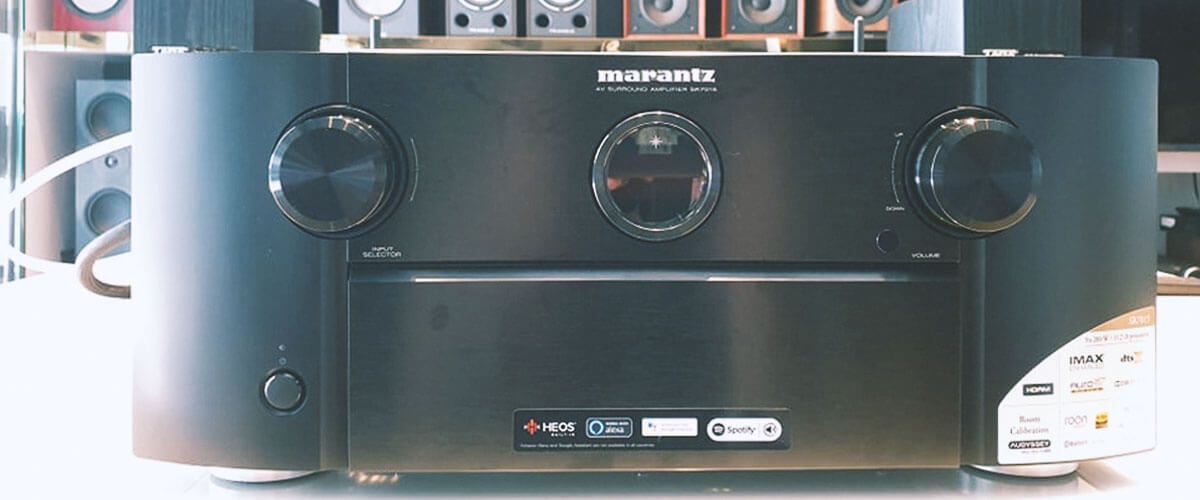
Turning to the main topic of my review, the surround sound formats that the SR7015 decodes are worth mentioning. Of course, it is our dear Dolby Atmos, but not only it. The receiver supports all the most popular immersive formats and their variants: DTS:X, IMAX Enhanced, and Auro-3D. And I drowned in the warmth and purity of Marantz sound. It is realistic, powerful, and just what you need for blockbusters using the upper channels. By the way, for those wary of the complexity of tuning, the SR7015 has Audyssey’s excellent MultEQ calibration system, which requires no manual intervention if you’re not too picky. And if you want to keep the kids busy in the evening, the receiver has Multiroom for 3 zones.
The Marantz SR7015 is the best Atmos receiver with 9 channels of amplification. Given its capabilities, outlook, and reliability, this receiver is the optimal solution for ambitious people who want to use the elite Marantz equipment, watch movies with Dolby Atmos surround sound, and listen to high-quality music. And some minor compromises are well compensated by its current price.
Key specs
- Channels: 9.2.
- Power output: 125W/8 Ohm, 165W/6 Ohm.
- HDMI inputs/outputs: 8/3.
- Video functions: 8K/60Hz, 4K/120Hz, 4K/60Hz pass-through, video upconversion (up to 1080p and 8K) for analog and HDMI sources.
- Bluetooth/Wi-Fi: yes/yes.
- Streaming services: AirPlay2, Deezer, Tidal, Pandora, SiriusXM, Napster, SoundCloud, Amazon Music, Amazon Music HD, Mood mix.
- Supports: HDMI ARC, HDMI eARC, HDMI CEC, HDCP2.3, HDR10, HDR10+, Dolby Vision.
- Surround sound: DTS HD Master, DTS Neural:X, Dolby TrueHD, Dolby Surround, Dolby Digital Plus, Dolby Atmos Height Virtualization, Dolby Atmos, Auro-3D, IMAX Enhanced, Multichannel stereo.
Pros
- Optimal price/quality ratio from the rating.
- Low THD allows you to listen to content at maximum volume without interference.
- The HDAM used in the design is better than conventional DUT ICs.
- Ability to listen to stereo through all speakers, creating a “music in surround sound” effect.
- Decodes the most popular surround sound formats.
Cons
- Only 1 HDMI input and 2 HDMI outputs support 8K video.
Denon AVR-X2800H – budget
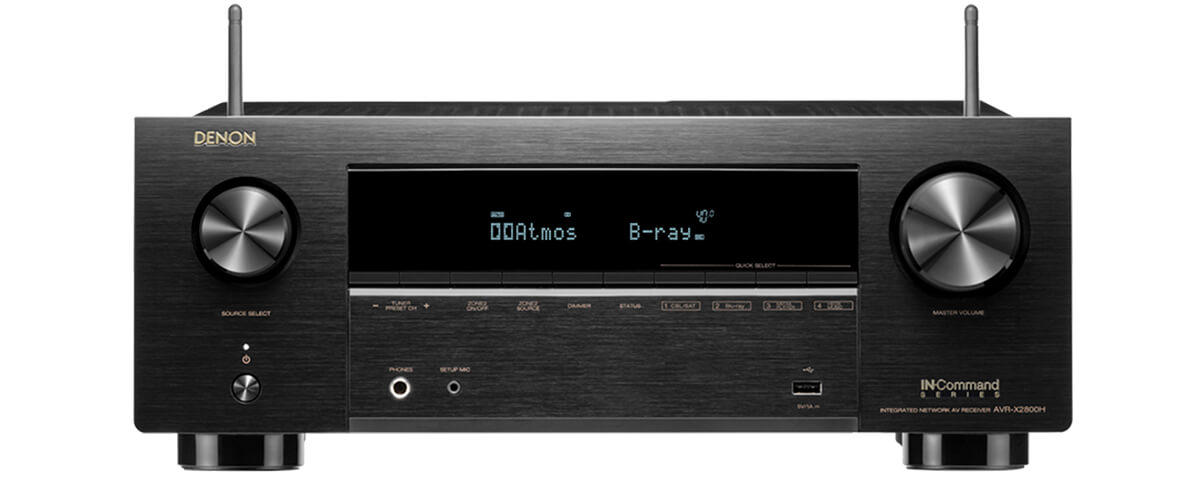
In the best-budget Dolby Atmos receiver category, the 7.2-channel receiver from Denon AVR-X2800H is the winner. In a minimum Dolby Atmos 5.2.2 configuration with the smallest power rating of 95W (8 ohms, 20Hz – 20kHz, 0.08%, 2ch), with this receiver, you can still experience the full impact of the high-res channels, and you’ll only need to place your home theater in a small room to do so. It also decodes the super-quality DTS:X surround sound format. For these qualities and Denon’s recognizable superior dynamic sound, the AVR-X2800H gets the second-place rating.
Unlike the Marantz SR7015, this model was released in 2022, and its few (relative to other AVRs on my list) HDMI ports (6/2) have version 2.1. Accordingly, you get all the benefits of modern AV signal transmission, namely HDCP2.3, eARC, CEC, resolution, and 8K upscaling for HDR10, HDR10+, Dolby Vision and HLG formats. Gamers will also appreciate the benefits of this signal broadcast. In other types of connectivity, the Denon AVR-X2800H is limited relative to the SR7015.
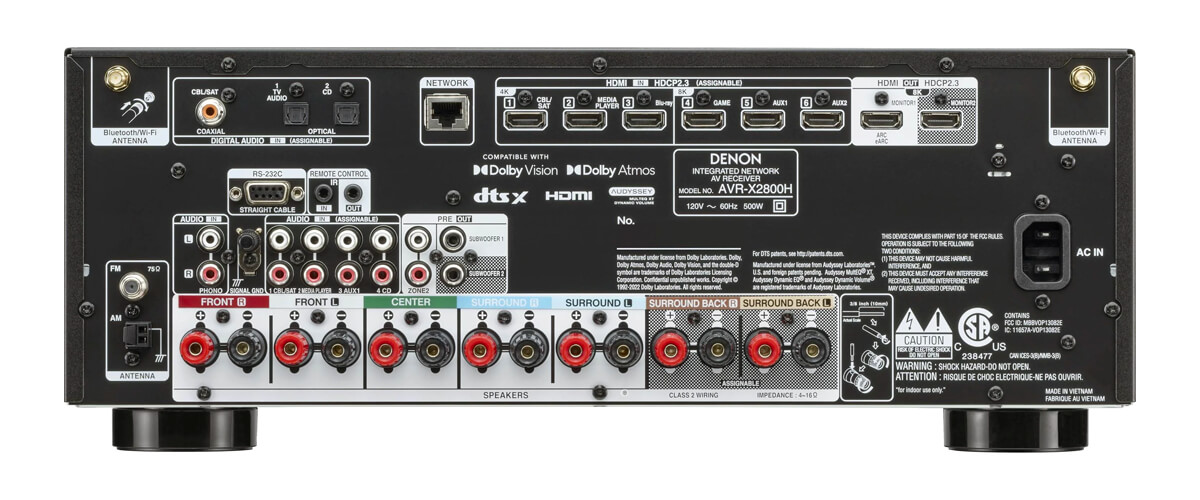
Otherwise, the model can compete with more premium models. Compensating for the simple aging design and simplicity of construction, Denon has put effort into the functionality of the X2800H. You have some jacks for connecting different types of appliances, phono input, bi-amping function, and multi-room audio for 2 zones. The receiver works with voice assistants and streaming services via dual-band Wi-Fi, Bluetooth, and a built-in HEOS system.
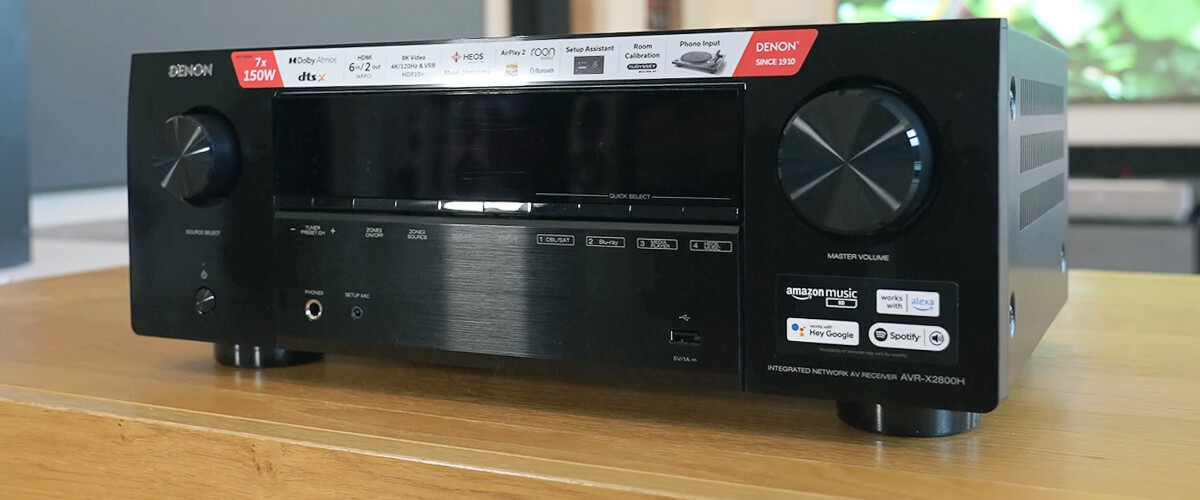
Also, Denon follows the tradition of focusing on the receiver’s sound. Dynamic, warm sound is distributed smoothly around the room, filling every corner with the same level of detail. The setup is simple and can be perfected with manual adjustments aided by a full-screen interface. And for people who are hard of hearing family members, there’s an option to listen to the soundtrack with headphones simultaneously. The only thing missing from the overall soundstage is the bass. They are dense and fat but not deep enough, so pick up as high-quality sub as possible.
Suppose you are satisfied with the minimum configuration of Dolby Atmos, or you have a small room to place your home theater. If you want a universal device for watching movies, listening to analog and digital music, and saving money, the Denon AVR-X2800H is ideal. In terms of sound quality and modern functionality, it quite worthily takes its place among the premium models of the rating.
Key specs
- Channels: 7.2.
- Power output: 95W/8 Ohm, 125W/6 Ohm.
- HDMI inputs/outputs: 6/2.
- Video functions: 8K/60Hz, 4K/120Hz, 4K/60Hz pass-through, 1080p to 8K/4K video upscaling via HDM.
- Bluetooth/Wi-Fi: yes/yes.
- Streaming services: AirPlay2, Deezer, Tidal, Pandora, Spotify, Amazon Music HD, TuneIn.
- Supports: HDMI ARC, HDMI eARC, HDMI CEC, HDCP2.3, HDR10, HDR10+, Dolby Vision.
- Surround sound: DTS HD Master, DTS Neural:X, Dolby TrueHD, Dolby Surround, Dolby Digital Plus, Dolby Atmos Height Virtualization, Dolby Atmos.
Pros
- All HDMI ports have version 2.1, so with a smaller number, the receiver gives better functionality in video than Marantz SR7015.
- Wireless connectivity and additional functionality are on par with premium models.
- Headphones can be used simultaneously with speakers.
- All functions work smoothly; I did not notice any irregularities in signal transmission.
- The sound level can compete with premium models.
Cons
- The lowest-powered receiver on the list, suitable for small rooms.
- 7 channels provide the minimum configuration for Dolby Atmos.
- The smallest number of HDMI and other types of connections in the rating. Equal to the functionality.
- Little bass.
Onkyo TX-RZ50 – also great
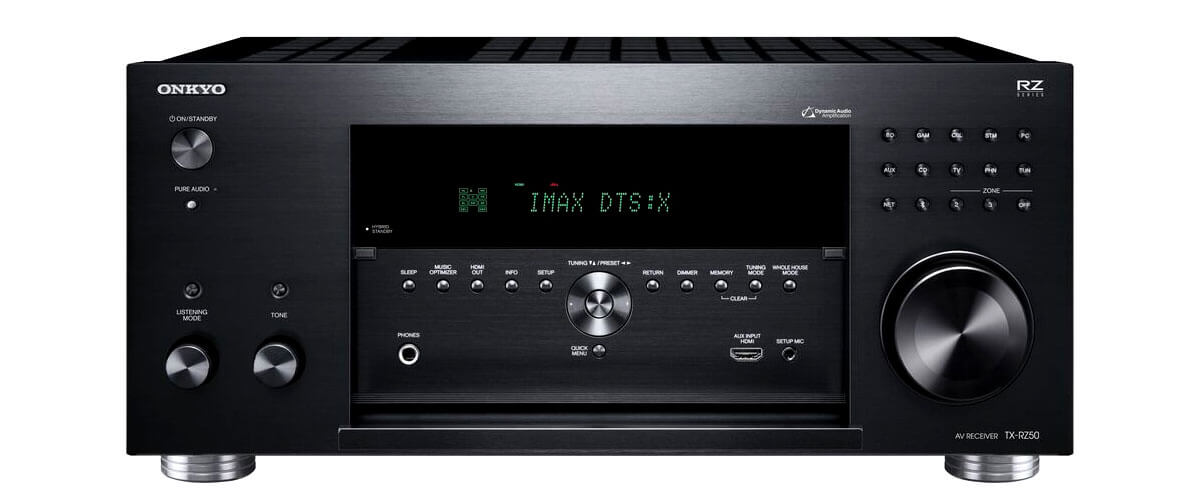
The Onkyo TX-RZ50 9.2-channel receiver can compete with the selection leader if you want to save money, as it costs a bit less. It can also be expanded to an 11-channel system with a rather high power output of 120 watts (8 ohms, 20 Hz – 20 kHz, 0.08% THD, 2 ch). But as you can see from the first lines of the description, we have slight differences regarding SR7015 because the THD indicator is higher than Marantz. So, a slight excess of power rating will not play a role in the final sound picture. And even the design itself is inferior to the winner by a significant margin. Its weight is small (30.9 pounds), the control buttons are unreliable, uncomfortable, and small, and it is almost impossible to read the inscriptions on them. This suggests that the manufacturer has skimped on the quality of construction and internal components.
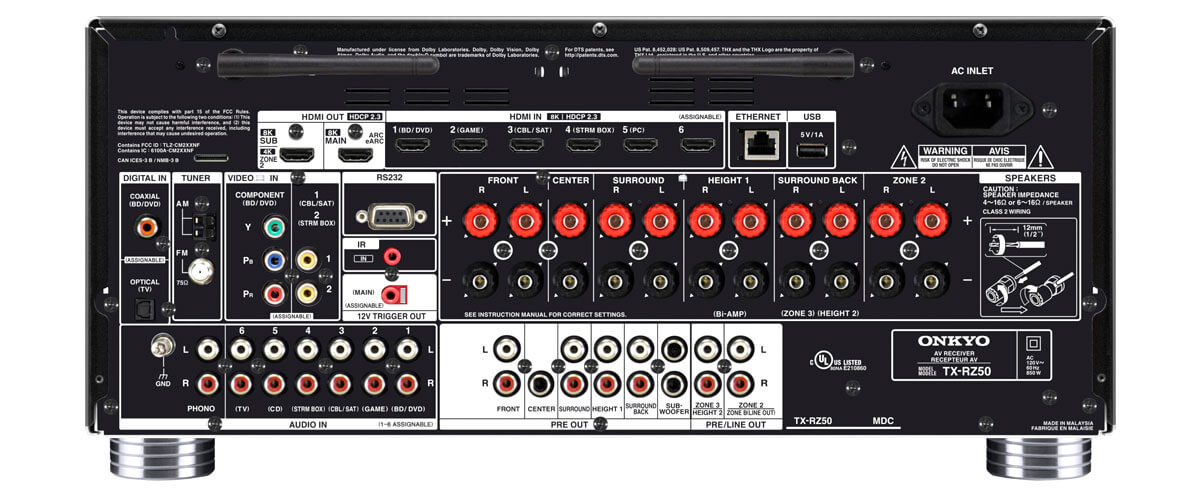
Onkyo TX-RZ50 has fewer HDMI connectors than the SR7015 (7/2), but they all cooperate with 8K video. The receiver was released in 2021, so its functionality won’t need upgrading long.
Regarding wireless connectivity, the TX-RZ50’s capabilities are also more advanced. Its DTS Play-Fi Ready and Bluetooth with support for AAC and aptX HD codecs more accurately transmit the signal from your Android or iOS devices. Of course, it cooperates with many streaming services, but you need to buy a separate device for Hey Google or Alexa voice assistants. You can also stream multi-room wireless audio using AirPlay 2 and Chromecast.
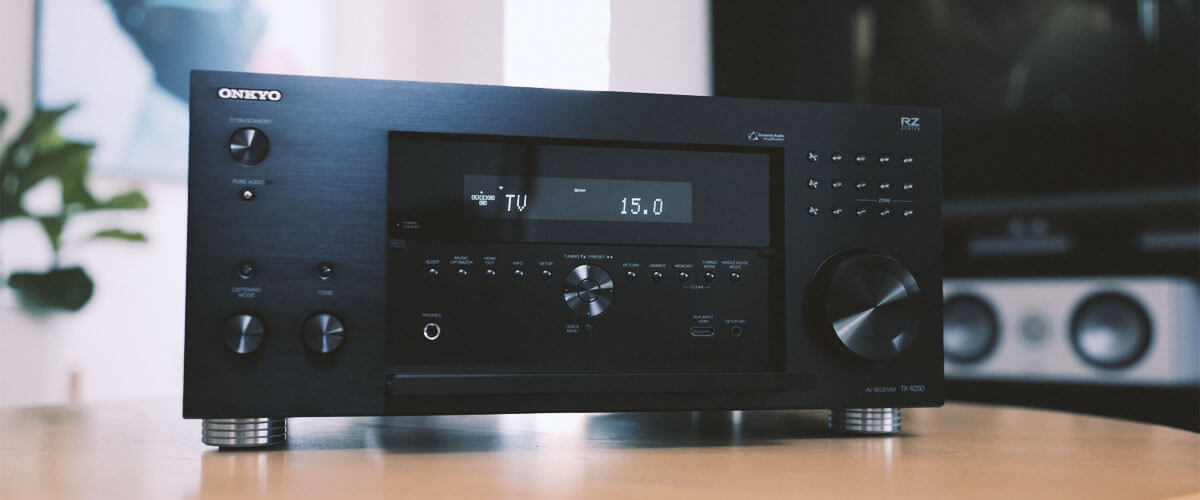
In the field of surround sound, TX-RZ50 showed itself very well. The sound is really great, but it doesn’t surpass other models in the rating. AVR decodes surround sound formats – Dolby Atmos, DTS:X, for which IMAX Enhanced technology is also implemented, but not Auro 3D. It’s worth mentioning THX Certified Select, which all Onkyo receivers in the premium range are equipped with. This is a high rating that speaks of high sound quality.
The Onkyo TX-RZ50 is a great alternative to more expensive 9.2 Atmos receivers, providing quality and clear sound even at high volume. Despite some minor compromises, its state-of-the-art features will keep it relevant for a long time.
Key specs
- Channels: 9.2.
- Power output: 120W/8 Ohm, 250W/6 Ohm.
- HDMI inputs/outputs: 7/2.
- Video functions: 8K/60Hz, 4K/120Hz, 4K/60Hz pass-through, video upconversion (up to 1080p and 8K) for analog and HDMI sources.
- Bluetooth/Wi-Fi: yes/yes.
- Streaming services: AirPlay2, Deezer, Tidal, Pandora, SiriusXM, Napster, SoundCloud, Amazon Music, Amazon Music HD, Mood mix.
- Supports: HDMI ARC, HDMI eARC, HDMI CEC, HDCP2.3, HDR10, HDR10+, Dolby Vision.
- Surround sound: DTS HD Master, DTS Neural:X, Dolby TrueHD, Dolby Surround, Dolby Digital Plus, Dolby Atmos Height Virtualization, Dolby Atmos, IMAX Enhanced
Pros
- Support for DTS Play-Fi Ready and Bluetooth AAC and aptX HD codecs.
- THX Certified Select certification means high-quality sound.
Cons
- Lightweight design implies the use of inexpensive internal components.
- You need to buy a separate device to use voice assistants.
- Does not support Auro 3D surround sound format.
Denon AVR-X6700H – premium
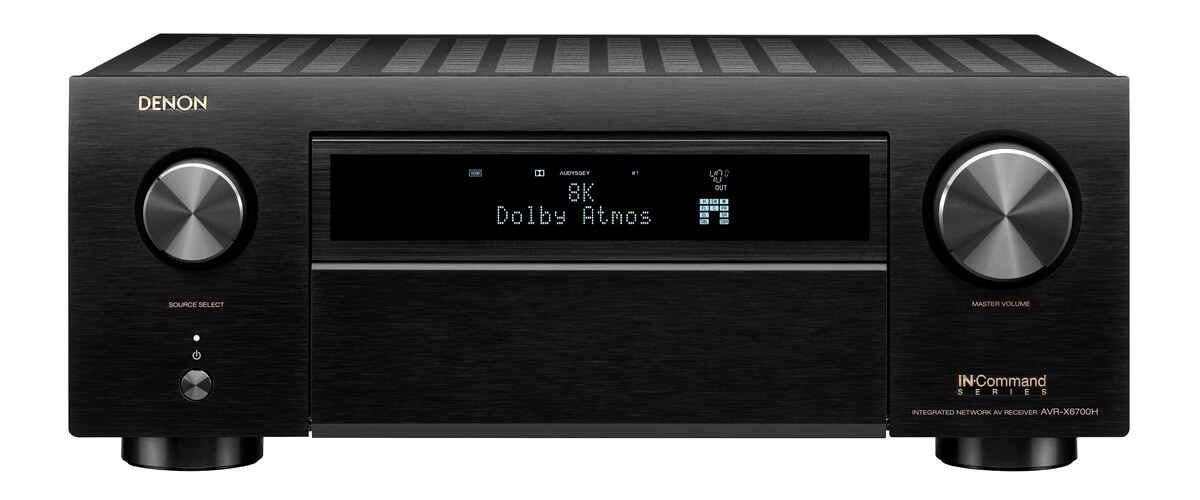
It’s not the fourth place. It’s just that I have two 11-channel receivers left in my arsenal, which, for objective reasons, are better suited for Dolby Atmos than systems with fewer channels. So, I present you Denon AVR-X6700H – a premium model created by the brand in 2020, but fantastic sounding, multifunctional, expandable up to 13 channels (!) and 140 watts per channel (8 ohms, 20 Hz – 20 kHz, 0.05%, 2ch). It will make your house shudder with explosions and battle scenes. Given the brand’s universally recognized brand dynamics and brightly colored dialog, it would be a stretch to say that I find myself enamored with this AVR. It’s worth watching the coolest movies with it, like Avatar, Star Wars, or King Arthur. I felt every moment like objects were moving around me. Delightful dispersion, you hear all levels, layers, and details of sound. In addition to Dolby Atmos, the receiver supports DTS:X (including Pro), DTS Neural:X, IMAX Enhanced, and Auro-3D surround sound formats.
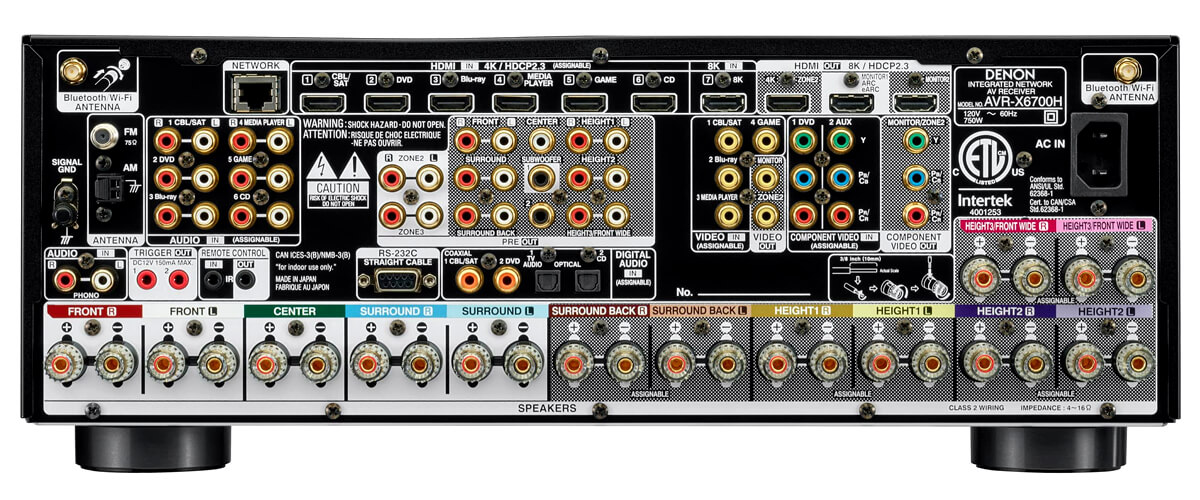
Speaking of sound, it is worth mentioning the unique technologies used in the model under consideration. This is D.D.S.C. (Dynamic Discrete Surround Circuit), which uses not a single chip but individual components, increasing signal processing performance. And ALPHA Processing processes a greater amount of information without losing quality. This has a significant impact on the overall soundstage.
With the AVR-X6700H, we are again faced with the fact that it only has 1 HDMI input with support for 8K video (there are 8/3 in total). I’d also like to note that switching between resolutions is noticeably less delayed than other models.
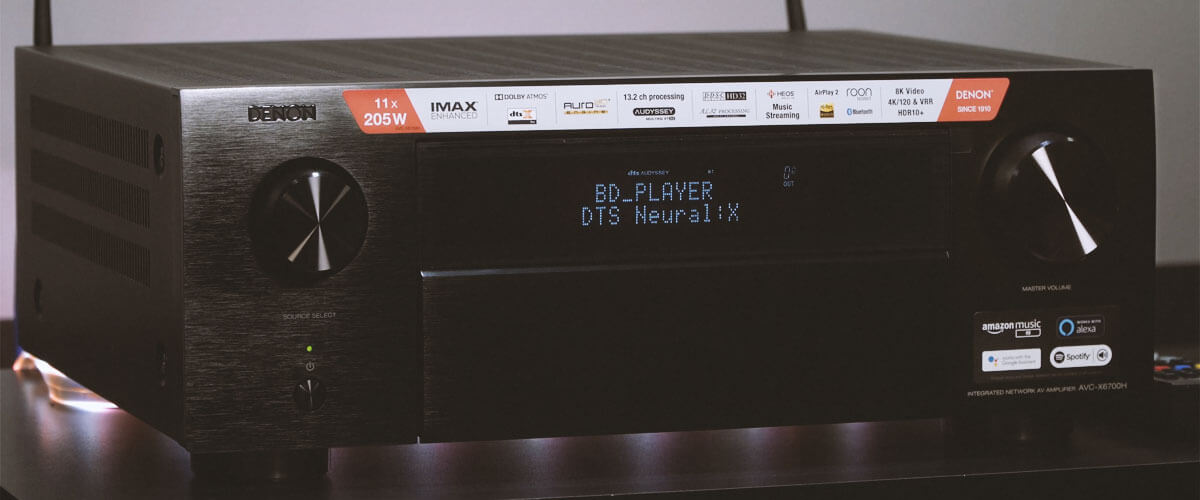
Perhaps I won’t repeat myself and list the other wired and wireless connectivity options. There are many of them, and all meet the requirements of a modern user. But I am somewhat annoyed by the slowness of the control application, although it greatly expands your possibilities.
Denon AVR-X6700H is the best receiver for Dolby Atmos, with the ability to expand the system up to 13 channels, giving you an unforgettable experience of Dolby Atmos effects. It is a truly worthy investment for years to come.
Key specs
- Channels: 11.2.
- Power output: 140W/8 Ohm, 175W/6 Ohm.
- HDMI inputs/outputs: 7/3.
- Video functions: 8K/60Hz, 4K/120Hz pass-though, upscaling up to 8K.
- Bluetooth/Wi-Fi: yes/yes.
- Streaming services: AirPlay 2, Spotify, TuneIn, Deezer, Tidal, Netflix, Amazon Prime.
- Supports: HDMI ARC, HDMI eARC, HDMI CEC, HDCP2.3, HDR10+, Dolby Vision.
- Surround sound: DTS:X, DTS Neural:X, DTS Virtual:X, Dolby Atmos, DTS HD Master, Dolby TrueHD, Dolby Atmos Height Virtualization, Dolby Atmos Music, Auro 3D.
Pros
- The only receiver of the selection with the ability to build a system 7.2.6 or 9.2.4 with an external amplifier.
- Stunning sound dispersion and dynamics.
- The use of high-end technology enhances the listening experience.
- Noticeably less delay when switching between different video resolutions.
- The Denon app has many control functions.
Cons
- Only 1 HDMI input with support for 8K video.
- The Denon app is slow.
Yamaha RX-A8A
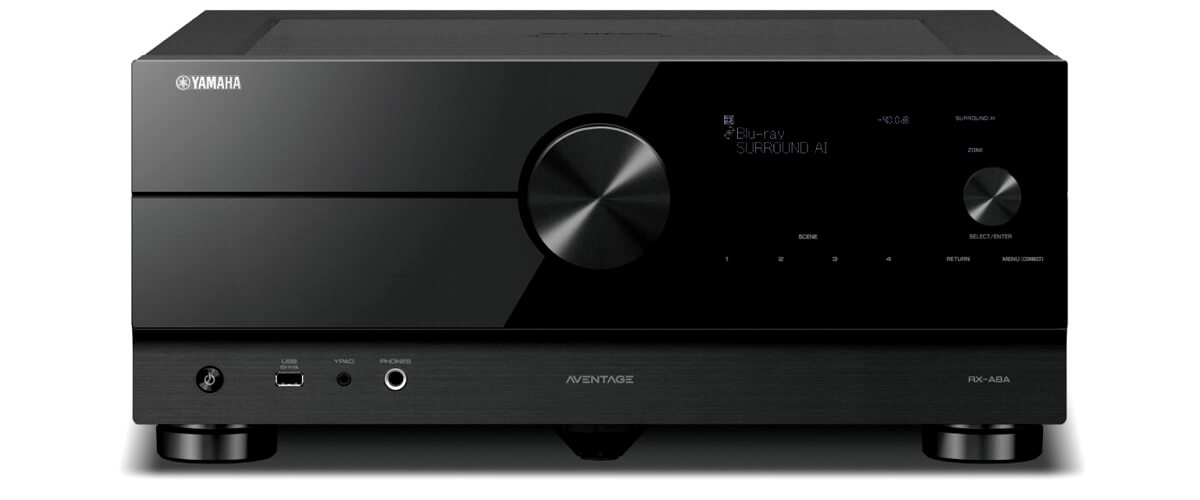
The last participant in my chart is an 11.2 Atmos receiver proudly named Yamaha RX-A8A. Being the flagship receiver of the brand and a representative of the elite Aventage line, this receiver will suit those not used to saving money, as it is the most expensive one in the review. This high cost is due to very expensive internal components, as evidenced by the receiver’s weight of 47.2 pounds. This is simply the heavyweight among all the competitors.
The RX-A8A is the most powerful in the ranking; it delivers 150 watts (8 ohms, 20Hz-20kHz, 0.06% THD, 2ch), but unlike the Denon AVR-X6700H, its configurations are limited to only 11 channels. But you do have Multiroom for 4 zones (vs. 3 for Denon).
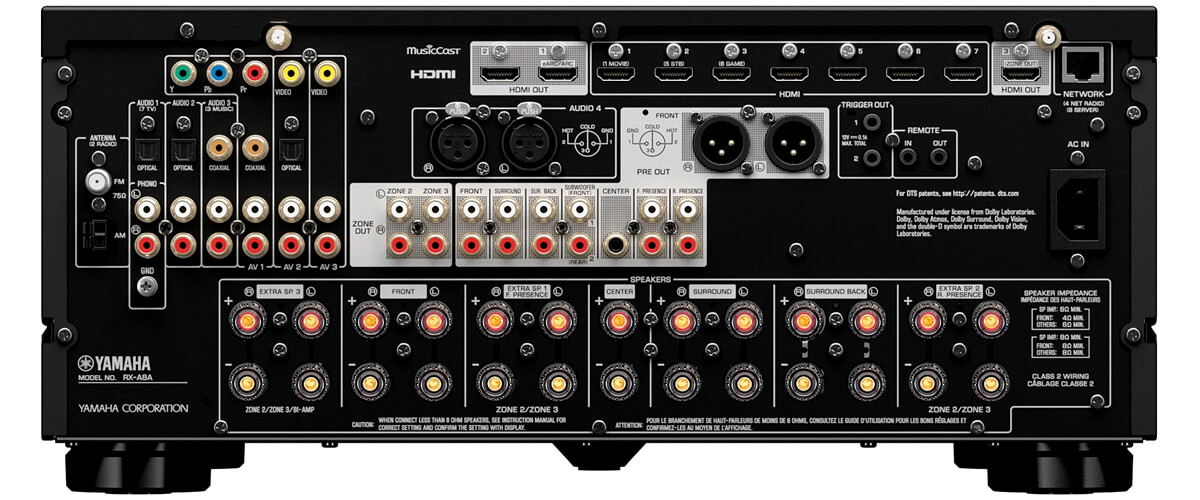
Also, unlike AVR-X6700H, Yamaha RX-A8A has 7/3 HDMI ports 2.1 with support for 8K video, but upscaling is possible only up to 4K. Otherwise, the receivers are very similar in their capabilities.
The sound of the RX-A8A is different from other receivers. Yamaha is known for its unique, recognizable, metallic cold, crystalline, crisp chased sound. So whether you like watching movies with it or not is purely a matter of your taste, but I’m sure many of you will enjoy it. But I assure you, the playback quality is top-notch and will satisfy those who know about sound. It is impressive during sword fights, for example, or in a Transformers movie. The specific grinding of metal is something incredible! Unforgettable.
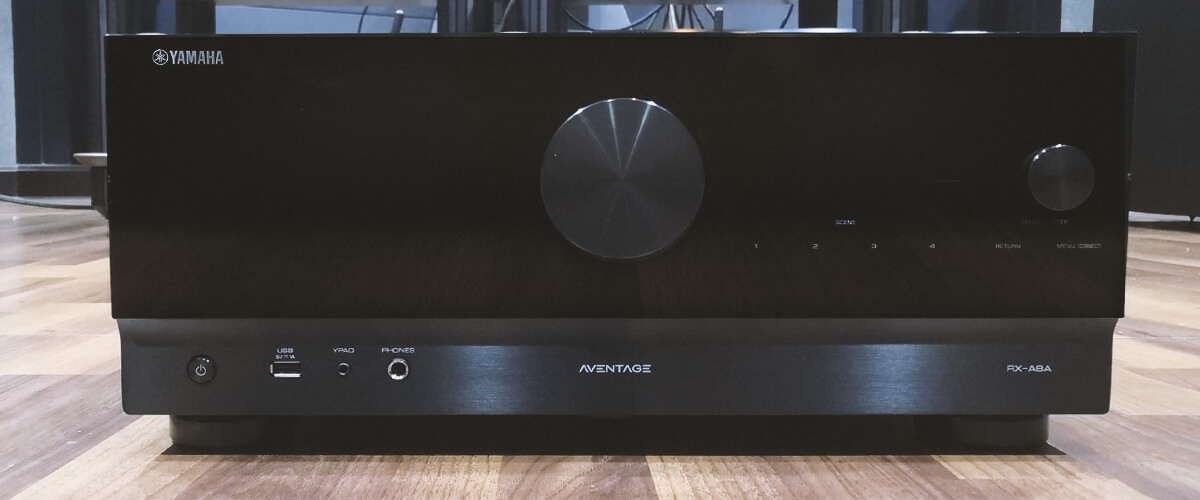
The receiver’s unique technologies include CINEMA DSP HD3 for DTS:X, which simulates up to 11 channels using only the front speakers, and Surround AI, built into the DSP, which self-analyzes scenes and highlights dialogue, backgrounds, and special effects right as you watch.
Yamaha RX-A8A – will satisfy the audio needs of even the sophisticated viewer. Its eliteness is evident in its design, controls, user menus, and, of course, in the quality of any signal, video or audio, multichannel or stereo sound. This is true prestige.
Key specs
- Channels: 11.2.
- Power output: 150W/8 Ohm.
- HDMI inputs/outputs: 7/3.
- Video functions: 8K/60Hz, 4K/120Hz, upscaling up to 8K.
- Bluetooth/Wi-Fi: yes/yes.
- Streaming services: AirPlay 2, Spotify, TuneIn, Deezer, Tidal, Netflix, Amazon Prime.
- Supports: HDMI ARC, HDMI eARC, HDMI CEC, HDCP2.3, HDR10+, Dolby Vision.
- Surround sound: DTS:X, DTS Virtual:X, Dolby Atmos, DTS HD Master, Dolby TrueHD, Auro 3D.
Pros
- The most powerful receiver on the list is 150 watts per channel.
- The massive weight indicates the use of expensive internal components.
- Multi-room for 4 zones.
- Surround AI analyzes and optimizes surround sound in real-time.
Cons
- Expanding the system up to 13 channels like Denon AVR-X6700H is impossible.
Factors to consider when buying a Dolby Atmos receiver
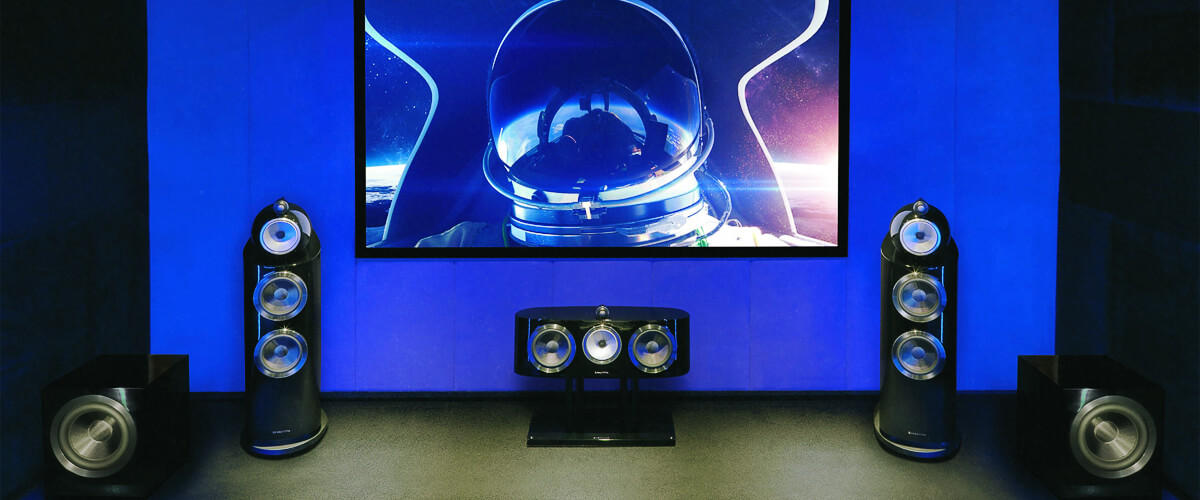
For you to really feel like you are in a movie theater, some factors are important that will make the effect of Dolby Atmos sound brighter. I will tell you what, in my experience, you should look for when choosing a receiver.
Power and wattage
The receiver must be selected correctly for the sound to spread evenly and smoothly throughout the room where your home theater is located. One of the rather important parameters is the power of the AVR. For example, 7-channel units are designed for 300-400 square feet rooms, 9-channel units are designed for 350-500, and so on. The receiver’s power is usually in a certain range, so you won’t have to research this issue for long. So, for a 7-channel system, the figure ranges from 75-100W, and so on.
But even this is not enough. It is extremely important that THD, which is responsible for sound clarity, should be below 1%. And the lower, the better (0.06-0.08% is considered good). Otherwise, how powerful your receiver is will not matter because, at high volumes, the speakers will produce wheezes and noises.
Connectivity options
When choosing a Dolby Atmos receiver, pay attention to the number and types of connection options it offers. HDMI inputs are very important for connecting video sources, so ensure you have enough HDMI ports and their version. HDMI guarantees you 8K signal transmission, video scaling from lower to higher resolutions, and other important features that will help you broadcast content from the source in its original form.
Video features
The Dolby Atmos video capabilities of your Dolby Atmos receiver are very important to your experience. After all, if the picture quality is poor, you’ll unlikely be able to immerse yourself in the movie fully. Look for receivers supporting video resolutions such as 4K or 8K with HDR (high dynamic range) Dolby Vision, HDR10, or HDR10+.
Surround sound formats
When you purchase a receiver that supports Dolby Atmos, you should not forget about other popular surround sound formats. I think it’s always better to watch a movie with its original track, and many offer several options as well.
No less respected among connoisseurs is DTS:X immersive format, which does not use ceiling speakers but has even more encoded soundtracks and is therefore considered richer, more detailed, and layered. Auro-3D surround sound encoding is less common but also greatly enhances the viewing experience. It uses an overhead layer for sound distribution and is only available starting with a 9-channel system.
Ease of use
Ease of use is another important consideration. A receiver with easy configuration and customization options ensures that you can easily fine-tune your audio and video. Look out for models with a well-designed on-screen display, intuitive remote control, and companion apps for smartphones and tablets.
We are supported by our audience. When you purchase through links on our site, we may earn an affiliate commission at no extra cost to you.
Our newsletter
* We will never send you spam or share your email with third parties

![Best Budget Receivers [Reviewed and Tested]](https://thetechholics.com/wp-content/uploads/2023/10/best-budget-av-receiver-300x150.jpg)
![Best 9-Channels AV Receivers [Reviewed and Tested]](https://thetechholics.com/wp-content/uploads/2023/10/best-9-2-receiver-300x150.jpg)

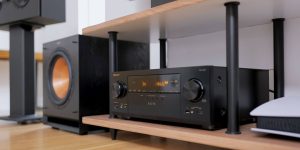
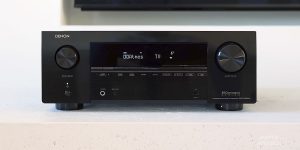
![Pioneer vs Denon Receivers [Top Models Compared and Tested]](https://thetechholics.com/wp-content/uploads/2023/10/denon-vs-pioneer-review-300x150.jpg)
